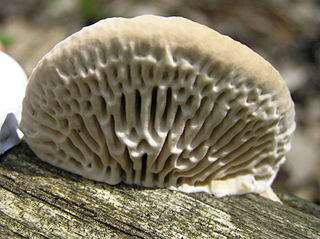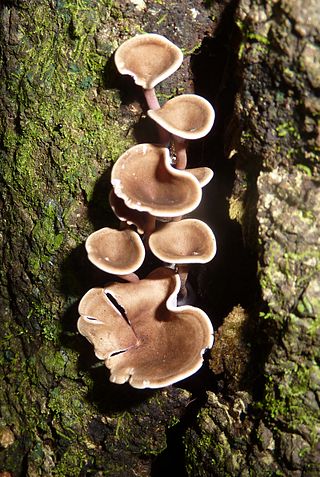
The Polyporales are an order of about 1800 species of fungi in the division Basidiomycota. The order includes some polypores as well as many corticioid fungi and a few agarics. Many species within the order are saprotrophic, most of them wood-rotters. Some genera, such as Ganoderma and Fomes, contain species that attack living tissues and then continue to degrade the wood of their dead hosts. Those of economic importance include several important pathogens of trees and a few species that cause damage by rotting structural timber. Some of the Polyporales are commercially cultivated and marketed for use as food items or in traditional Chinese medicine.

The Polyporaceae are a family of poroid fungi belonging to the Basidiomycota. The flesh of their fruit bodies varies from soft to very tough. Most members of this family have their hymenium in vertical pores on the underside of the caps, but some of them have gills or gill-like structures. Many species are brackets, but others have a definite stipe – for example, Polyporus badius.

Gloeoporus dichrous is a species of fungus in the family Irpicaceae. First described as Polyporus dichrous by Elias Magnus Fries in 1815, it was later transferred to the genus Gloeoporus by Italian mycologist Giacomo Bresadola in 1912. The variety G. dichrous var. niger was proposed in 2008, after molecular analysis revealed the two taxa were conspecific. G. dichrous is inedible.

Mentha cervina, commonly known as hart's pennyroyal, is a perennial herbaceous plant of the Mentha (mint) genus. It is native to the western Mediterranean Sea region, growing naturally from southwestern France to the Iberian Peninsula, and south to Azores, Morocco and Algeria. Its common name reflects a traditional association with the separate species Mentha pulegium or pennyroyal. The plants were associated due to their shared high pulegone content, which gives them both a distinctive, strong aroma.

Daedalea is a genus of fungi in the family Fomitopsidaceae. The genus was circumscribed in 1801 by mycologist Christian Hendrik Persoon, based on the type D. quercina and four other species. The generic name is derived from the Ancient Greek δαιδαλεος.

Phylloporia is a genus of polypore fungi in the family Hymenochaetaceae. A 2012 estimate placed 23 species in the genus; this number was increased to 30 by 2015.

Meruliopsis is a genus of poroid crust fungi. The genus was circumscribed by Russian mycologist Appollinaris Semenovich Bondartsev in 1959.

Ramonia is a genus of lichenized fungi in the family Gyalectaceae. It contains 24 species. The genus was circumscribed by Ernst Stizenberger in 1862.

Trogia is a genus of fungi in the family Marasmiaceae. It is named after a Swiss mycologist Jacob Gabriel Trog. The genus contains about 20 species that are widely distributed in tropical areas.

Steccherinum is a widely distributed genus of toothed crust fungi in the family Steccherinaceae.

Aurantiporus is a genus of poroid fungi in the family Meruliaceae. Circumscribed by American mycologist William Alphonso Murrill in 1905, the genus contains five species found mostly in northern temperate regions. Molecular analysis of several Aurantiporus species suggests that the genus is not monophyletic, but some other related polypore species need to be sequenced and studied before appropriate taxonomic changes can be made. In 2018, Viktor Papp and Bálint Dima proposed a new genus Odoria to contain Aurantiporus alborubescens based on multigene phylogenetic analyses. The generic name is derived from the Latin aurantius ("orange") and the Ancient Greek πόρος (pore).

Spongipellis is a genus of fungi in the family Polyporaceae. The genus is widely distributed and contains ten species. The genus was circumscribed by French mycologist Narcisse Théophile Patouillard in 1887. The genus name combines the Latin words spongia ("sponge") and pellis ("skin").
Viridrillia is a genus of sea snails, marine gastropod mollusks in the family Pseudomelatomidae.

Microglossum viride is a species of fungus in the family Geoglossaceae. They are commonly called green earth tongues.
Rickiopora is a fungal genus of unknown familial placement in the order Polyporales. The genus is monotypic, containing the single neotropical species Rickiopora latemarginata.

The Irpicaceae are a family of mostly polypores and crust fungi in the order Polyporales.
Dumbea is a genus of leaf beetles in the subfamily Eumolpinae. It is known from the South Province and Mont Panié of New Caledonia, and is named after Dumbéa, a town nearby Nouméa. This name was originally used by the French entomologist Charles Adolphe Albert Fauvel to house several species of Eumolpinae from New Caledonia, but Fauvel's Dumbea was unpublished and is a nomen nudum. The genus was established based on general proportions and body size, and may be polyphyletic or paraphyletic.
Montrouzierella is a genus of leaf beetles in the subfamily Eumolpinae. It is known from the South Province and Mont Panié of New Caledonia, and is named after Xavier Montrouzier, the pioneer entomologist of New Caledonia. The genus was established based on general proportions and body size, and may be polyphyletic or paraphyletic.
Samuelsonia is a genus of leaf beetles in the subfamily Eumolpinae. It is known from the South Province and Mont Panié of New Caledonia, and is named after Dr. G. Allan Samuelson of the Bishop Museum. The genus was established based on general proportions and body size, and may be polyphyletic or paraphyletic.

Dematochroma is a genus of leaf beetles in the subfamily Eumolpinae. It is mostly distributed in New Caledonia, though it is also found on Lord Howe Island, Norfolk Island and Timor. Adult beetles are often found at night feeding on leaves, and the larvae eat roots.















